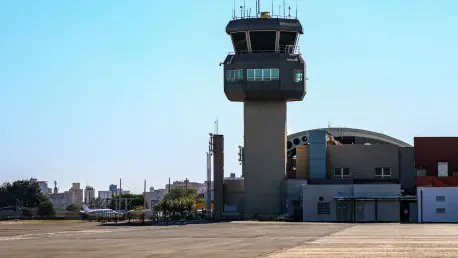What happens when the system responsible for guiding millions of passengers through the busiest airspace in the world teeters on the edge of collapse? The U.S. Air Traffic Control (ATC) system, overseen by the Federal Aviation Administration (FAA), manages over 2.9 million travelers daily, yet it struggles with outdated technology, chronic understaffing, and unpredictable funding, making its fragility a growing concern. A single government shutdown can slash operations at major airports by 4%, exposing a weakness that threatens not just delays, but lives. This isn’t a distant concern—it’s a pressing reality demanding answers about why such a critical operation remains tethered to government control.
The importance of this issue cannot be overstated. Aviation is the backbone of global connectivity, and the U.S. system’s failures ripple across economies, disrupt travel, and endanger safety. High-profile incidents, like the tragic collision at Reagan National Airport, serve as stark reminders of what’s at stake. With nearly 90% of control towers understaffed and aging equipment leading to frequent near misses, the urgency for reform is clear. This story delves into the systemic flaws holding the ATC system hostage and explores whether breaking free from government oversight could chart a safer, more efficient path.
A System Under Strain: The Breaking Point of U.S. ATC
The U.S. ATC system is buckling under pressures that have been building for years. Outdated radar and routing methods, some dating back decades, force planes to take longer paths, burn more fuel, and struggle to adapt during adverse weather. These inefficiencies don’t just frustrate passengers—they heighten risks, as seen in the increasing number of close calls reported annually. The FAA, tasked with managing this sprawling network, often finds itself paralyzed by constraints beyond its control.
Government shutdowns exacerbate an already dire situation. When federal funding halts, unpaid controllers are forced to stay home, slashing capacity at key hubs. A recent shutdown saw 40 major airports cut operations by 4%, with ripple effects felt nationwide. Even without such crises, the system operates on a razor’s edge, unable to keep pace with the relentless growth of air travel. The question looms: how long can this patchwork approach hold before a catastrophic failure?
The High Cost of Government Oversight: Risks and Realities
Beneath the surface of delayed flights and overworked staff lies a deeper problem: political interference. Congress controls the FAA’s budget, often tying funding to short-term priorities rather than long-term needs. A proposed $31.5 billion modernization plan was gutted to just $12.5 billion, with strict stipulations that hinder flexibility. Such micromanagement stifles innovation, leaving the U.S. lagging behind nations that have modernized their skies.
Safety hangs in the balance as a result. Obsolete technology contributes to inefficiencies, while understaffing—already at critical levels with 90% of towers short on personnel—strains controllers to their limits. The deadly incident at Reagan National Airport wasn’t an isolated event; it was a warning. If political gridlock continues to dictate the fate of ATC, the system risks becoming a relic unfit for modern demands, endangering millions who rely on safe air travel every day.
Voices From the Front Lines: What Experts and Insiders Say
Transportation Secretary Sean Duffy has been vocal about the crisis, stating, “The current funding model is a barrier to progress, stalling upgrades that could save lives.” His frustration echoes a broader sentiment among aviation experts who point to data showing the U.S. as an outlier in clinging to government-run ATC. Countries like Canada and New Zealand, which shifted to privatized models decades ago, report fewer delays and cutting-edge systems—a stark contrast to the U.S. experience.
Controllers themselves paint a grim picture of working conditions. One veteran, speaking anonymously, described the shutdown’s toll: “We’re running on fumes, held together by grit, not resources. Every shift feels like a gamble.” Studies back these accounts, revealing that inconsistent budgets and staffing shortages directly correlate with safety risks. The consensus among insiders and analysts is unmistakable: maintaining the status quo is a dangerous bet with stakes too high to ignore.
Global Lessons: How Other Nations Reinvented Their Skies
Across the globe, several countries have tackled similar challenges by reimagining ATC management. Canada’s transition to a nonprofit, independent entity in the late 1980s brought steady funding through user fees, enabling rapid technology upgrades. New Zealand followed suit, slashing delays and boosting efficiency. Germany and Japan have also adopted models that insulate operations from political whims, using bonds to finance large-scale projects while maintaining strict safety oversight.
These examples offer a blueprint for the U.S., highlighting the benefits of financial autonomy. Privatized systems aren’t perfect, but data shows they consistently outperform government-run counterparts in modernization and reliability. For the U.S., with its uniquely complex airspace, adapting these lessons could mean shorter flights, fewer incidents, and a system equipped to handle future growth. The evidence suggests that looking abroad might hold the key to transformation.
A Roadmap for Change: Privatization as the Path Forward
Envisioning a reformed U.S. ATC system starts with breaking free from government constraints. Shifting to an independent, nonprofit entity, funded by user fees and bonds, could provide the stability needed for sweeping upgrades. This model, proven in nations like Germany, would sidestep Congressional gridlock, ensuring resources flow directly to critical needs like new technology and staff retention.
Safety must remain paramount during any transition. The FAA could retain its role as a regulator, setting strict standards while allowing operational freedom for innovation. Immediate measures, such as a proposed $10,000 bonus for controllers who endured shutdowns, could stabilize morale in the interim. Drawing on global best practices—while avoiding missteps like the failed reform push in recent administrations—offers a practical way to rebuild trust and efficiency in American skies.
Looking back, the struggle to modernize U.S. air traffic control stood as a testament to systemic inertia, where political barriers repeatedly trumped urgent needs. Yet, the path forward grew clearer with each lesson learned from global peers. Action demanded urgency—policymakers had to prioritize privatization, ensuring steady funding and independence for ATC operations. Beyond that, sustained investment in technology and personnel promised to restore safety as a non-negotiable standard. The nation’s aviation future hinged on bold steps taken then, setting a course toward skies that were not just busy, but reliably secure for generations to come.









